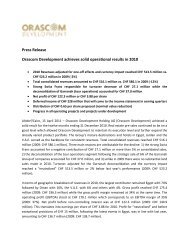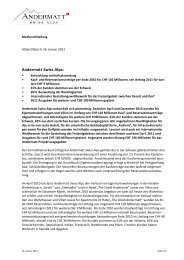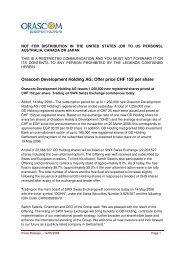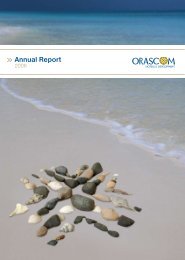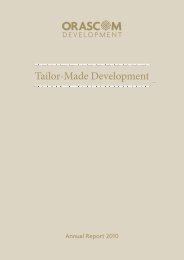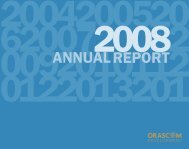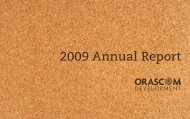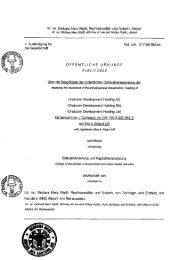FY 2012 Annual Report - Orascom Development
FY 2012 Annual Report - Orascom Development
FY 2012 Annual Report - Orascom Development
You also want an ePaper? Increase the reach of your titles
YUMPU automatically turns print PDFs into web optimized ePapers that Google loves.
F-21 <strong>Orascom</strong> <strong>Development</strong> <strong>2012</strong> <strong>Annual</strong> <strong>Report</strong> F-22<br />
impacts profit or loss. The hedged interest component of the qualifying asset (hedged risk) impacts profit or loss when the<br />
qualifying asset is amortized, impaired or sold.<br />
– Where fixed rate borrowings are used to finance a qualifying asset and a derivative is designated to hedge the fair value<br />
exposure to changes in interest rates of such borrowings, the synthetic floating interest rate that is achieved as a result of a<br />
highly effective hedge is capitalized, so that borrowing costs always reflect the hedged interest rate. The amount of borrowing<br />
costs capitalized in such a case comprises the actual fixed rate on the borrowings plus the effect of swapping this fixed rate<br />
into floating rates.<br />
Investment income earned on the temporary investment of specific borrowings pending their expenditure on qualifying assets is<br />
deducted from the borrowing costs eligible for capitalisation.<br />
All other borrowing costs are recognised in profit or loss in the period in which they are incurred.<br />
As the financing activity is co-ordinated centrally and generally by the parent and some of the main subsidiaries, the group<br />
determines the amount of borrowing costs eligible for capitalisation by applying a capitalisation rate to the expenditures on that<br />
asset. The group includes all borrowings of the parent and its subsidiaries when computing the weighted average of the borrowing<br />
costs applicable to the borrowings that are outstanding during the period other than borrowings made specifically for the purpose<br />
of obtaining a qualifying asset.<br />
The amount of borrowing costs that an entity capitalises during the period shall not exceed the amount of borrowing costs it<br />
incurred during that period, provided that the carrying amount of the qualifying asset on which eligible borrowing costs have been<br />
capitalized does not exceed its recoverable amount (being the higher of fair value less costs to sell or amount in use for that asset).<br />
3.11 Government grants<br />
Government grants are not recognised until there is reasonable assurance that the Group will comply with the conditions attached<br />
to them and that the grants will be received.<br />
Government grants are recognised in profit or loss on a systematic basis over the periods in which the Group recognises as<br />
expenses the related costs for which the grants are received.<br />
Government grants whose primary condition is that the Group should purchase, construct or otherwise acquire non-current assets<br />
are recognised as deferred revenue in the consolidated statement of financial position and transferred to profit or loss on a<br />
systematic and rational basis over the useful lives of the related assets.<br />
Government grants that are receivable as compensation for expenses or losses already incurred or for the purpose of giving<br />
immediate financial support to the Group with no future related costs are recognised in profit or loss in the period in which they<br />
become receivable.<br />
The benefit of a government loan granted at below-market interest rates of interest is treated as a government grant and<br />
measured as the difference between proceeds received and the fair value of the loan based on prevailing market interest rates.<br />
3.12 Retirement benefit costs<br />
Employee pension and retirement benefits are based on the regulations and prevailing circumstances of those countries in which<br />
the Group is represented. In Switzerland, ordinary pension and retirement benefit plans qualify as defined-benefit plans and are<br />
accounted for in conformity with IAS 19 Employee Benefits.<br />
For defined benefit retirement benefit plans, the cost of providing benefits is determined using the Projected Unit Credit Method,<br />
with actuarial valuations being carried out at the end of each reporting period. Actuarial gains and losses that exceed 10 percent of<br />
the greater of (i) the present value of the Group’s defined benefit obligation and (ii) the fair value of plan assets as at the end of the<br />
prior year are amortised over the excepted average remaining working lives of the participating employees.<br />
Past service-costs are recognised immediately in profit or loss to the extent that the benefits are already vested, and otherwise are<br />
amortized on a straight-line basis over the average period until the benefits become vested.<br />
The retirement benefit obligation recognised in the consolidated statement of financial position represents the present value of<br />
the defined benefit obligation as adjusted for unrecognised actuarial gains and losses and unrecognised past service cost, and as<br />
reduced by the fair value of plan assets. Any asset resulting from this calculation is limited to unrecognised actuarial losses and<br />
past service cost, plus the present value of available refunds and reductions in future contributions to the plan.<br />
Payments to defined contribution retirement benefit plans are recognised as an expense when employees have rendered service<br />
entitling them to the contribution.<br />
3.13 Taxation<br />
Income tax expense represents the sum of the tax currently payable and deferred tax.<br />
3.13.1 Current tax<br />
The tax currently payable is based on taxable profit for the year. Taxable profit differs from profit as reported in the consolidated<br />
statement of comprehensive income because of items of income or expense that are taxable or deductible in other years and<br />
items that are never taxable or deductible. The Group’s liability for current tax is calculated using tax rates that have been enacted<br />
or substantively enacted by the end of the reporting period.<br />
F-21<br />
3.13.2 Deferred tax<br />
Deferred tax is recognised on temporary differences between the carrying amounts of assets and liabilities in the consolidated<br />
financial statements and the corresponding tax bases used in the computation of taxable profit, and are accounted for using the<br />
Balance Sheet Liability Method.<br />
Deferred tax liabilities are generally recognised for all taxable temporary differences. Deferred tax assets are generally recognised<br />
for all deductible temporary differences to the extent that it is probable that taxable profits will be available against which those<br />
deductible temporary differences can be utilized.<br />
Such deferred tax liabilities are not recognised if the temporary difference arises from goodwill and no deferred tax assets or<br />
liabilities are recognised for temporary differences resulting from the initial recognition (other than in a business combination) of<br />
other assets and liabilities in a transaction that affects neither the taxable profit nor the accounting profit.<br />
Deferred tax liabilities are recognised for taxable temporary differences associated with investments in subsidiaries and<br />
associates, and interests in joint ventures, except where the Group is able to control the reversal of the temporary difference and it<br />
is probable that the temporary difference will not reverse in the foreseeable future.<br />
Deferred tax assets arising from deductible temporary differences associated with such investments and interests are only<br />
recognised to the extent that it is probable that there will be sufficient taxable profits against which to utilize the benefits of the<br />
temporary differences and they are expected to reverse in the foreseeable future.<br />
The carrying amount of deferred tax assets is reviewed at the end of each reporting period and reduced to the extent that it is no<br />
longer probable that sufficient taxable profits will be available to allow all or part of the asset to be recovered.<br />
Deferred tax assets and liabilities are measured at the tax rates that are expected to apply in the period in which the liability is<br />
settled or the asset realised, based on tax rates (and tax laws) that have been enacted or substantively enacted by the end of the<br />
reporting period. The measurement of deferred tax liabilities and assets reflects the tax consequences that would follow from the<br />
manner in which the Group expects, at the end of the reporting period, to recover or settle the carrying amount of its assets and<br />
liabilities.<br />
Deferred tax assets and liabilities are offset when there is a legally enforceable right to set off current tax assets against current tax<br />
liabilities and when they relate to income taxes levied by the same taxation authority and the Group intends to settle its current<br />
tax assets and liabilities on a net basis.<br />
3.13.3 Current and deferred tax for the year<br />
Current and deferred tax are recognised as an expense or income in profit or loss, except when they relate to items that are<br />
recognised in other comprehensive income or directly in equity, in which case, the current and deferred tax are also recognised in<br />
other comprehensive income or directly in equity respectively. Where current tax or deferred tax arises from the initial accounting<br />
for a business combination, the tax effect is included in the accounting for the business combination.<br />
3.14 Property, plant and equipment<br />
Buildings, plant and equipment, furniture and fixtures held for use in the production, supply of goods or services or for<br />
administrative purposes are stated in the consolidated statement of financial position at cost less any accumulated depreciation<br />
and accumulated impairment losses.<br />
Properties in the course of construction for production, administrative purposes or for a currently undetermined future use are<br />
carried at cost less any recognised impairment loss. Cost includes professional fees and, for qualifying assets, borrowing costs<br />
capitalized in accordance with the Group’s accounting policy as described in note 3.10. Such properties are classified to the<br />
appropriate categories of property, plant and equipment when completed and ready for intended use. Depreciation of these<br />
assets, on the same basis as other property assets, commences when the assets are ready for their intended use.<br />
Depreciation of buildings, plant and equipment as well as furniture and fixtures commences when the assets are ready for their<br />
intended use.<br />
Freehold land is not depreciated.<br />
Depreciation is recognized so as to write off the cost of assets (other than freehold land and properties under construction) less<br />
their residual values over their estimated useful lives, using the straight-line method. The estimated useful lives, residual values<br />
and depreciation method are reviewed at the end of each reporting period, with the effect of any changes in estimate accounted<br />
for on a prospective basis.<br />
Assets held under finance leases are depreciated over their expected useful lives on the same basis as owned assets. However,<br />
when there is no reasonable certainty that ownership of the leased asset will be obtained by the end of the lease term, assets are<br />
depreciated over the shorter of the lease term and their useful lives.<br />
An item of property, plant and equipment is derecognised upon disposal or when no future economic benefits are expected to<br />
arise from the continued use of the asset. Any gain or loss arising on the disposal or retirement of an item of property, plant and<br />
equipment is determined as the difference between the net sales proceeds and the carrying amount of the asset and is recognised<br />
in profit or loss.<br />
F-22



